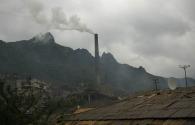At-A-Glance Views

Waste by-products are chemicals produced and released unintentionally into the environment by combustion or some chemical processes. Dioxins, a class of POPs, are by-products of waste incineration, chemical and pesticide manufacturing, and pulp and paper bleaching. The most potent dioxin, 2,3,7,8-TCDD, is a known human carcinogen.
Some persistent organic pollutants (POPs) are by-products that were produced unintentionally and released to the environment during combustion or during some chemical processes. For example, dioxins, furans, alpha-HCH, and beta-HCH are never intentionally produced (except for laboratory purposes). Dioxin, for example, one of the original "Dirty Dozen" of the Stockholm Convention, is typically produced during incineration. Two others, PCBs and HCB, are produced both intentionally and unintentionally.
The Stockholm Convention’s goal for unintentionally produced POPs is their continuing minimization and, where feasible, ultimate elimination. Parties to the Convention are obliged to develop an action plan to advance toward this goal, and they are obliged to implement the plan. As part of the plan, each Party should develop and maintain a national inventory of sources of unintentionally produced POPs together with an estimate of releases. Parties are obliged to promote measures that will reduce the releases of unintentional POPs or eliminate their sources. Parties are also obliged to promote the development of substitute or modified materials, products and processes to prevent the formation and release of unintentionally produced POPs. More specifically, Parties are obliged to promote the use of best available techniques (BAT) and best environmental practices (BEP) to control the unintentional POPs sources identified in its inventory, and Parties are obliged to require the use of BAT to control certain sources.
The Convention lists certain source categories that have the potential for comparatively high formation and release of unintentionally produced POPs such as doixns, furans, HCB and PCBs to the environment. These are:
- Waste incinerators for municipal, hazardous and medical waste and sewage sludge;
- Cement kilns firing hazardous waste;
- Production of pulp that uses chlorine bleach; and
- Certain thermal processes in the metallurgical industry - secondary copper production, sinter plants in iron and steel manufacture, secondary aluminum production and secondary zinc production.
Neither alpha-HCH nor beta-HCH is intentionally produced or placed on the market. Significant amounts of both substances are produced during the manufacture of technical hexachlorocyclohexane (HCH). Technical HCH has been used as a pesticide and also in the manufacture of lindane.
POP By-Products currently included in the Stockholm Convention are:
- hexachlorobenzene (HCB)
- hexachlorobutadiene (HCBD)
- polychlorinated biphenyls (PCB)
- polychlorinated dibenzo-p-dioxins
- polychlorinated dibenzofurans (PCDD/PCDF), and PCBs
- polychlorinated naphthalenes
- alpha hexachlorocyclohexane
- beta hexachlorocyclohexane
- pentachlorobenzene
For information about these POPs' original uses and production, characteristics, and listings in the Convention, see the Stockholm Convention website.
Main Right Block
Debug toxic priority variant
